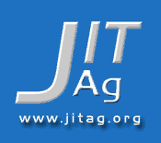Tips for Writing for the Journal of Extension
The Journal of Extension (JITAG) is the official refereed journal of a world-wide coalition.
JITAg is published in electronic format only and is accessed on
the Web at
www.JITAg.org.
JITAg is a peer-reviewed journal that expands and updates the research and knowledgebase for Agricultural IT professionals and other adult educators. The purpose of writing for JITAg is to share with your colleagues successful educational applications, original and applied research findings, scholarly opinions, educational resources, and challenges on publications of critical importance to agricultural professionals.
• Become familiar with JITAg by reading it. You can access the current publication and back publications at www.JITAg.org. From there you can also find the JITAG submission guidelines and other useful information about the journal.
• Follow the submission guidelines. They contain information on types and lengths of articles appropriate for JITAg, the style manual used by JITAg, and submission and layout formats and procedures. The guidelines are regularly updated, so it’s a good idea to check them before you start writing and also before you submit your article.
• Plan your article for the broadest possible audience of agricultural professionals.
• Write your article with the Web and on-screen reading in
mind. Favor active
voice over passive voice. Use shorter sentences and paragraphs, and
more bullet and numbered lists than are conventional in traditional,
on-paper journals. Brevity and clarity, the hallmarks of effective
writing, are even more important on the Web.
• Keep a clear and narrow focus by sticking to one main point
or theme.
Make sure your article “flows” well and is easy to follow
and understand.
• Remember the basics. Place any literature review near your introduction; keep your findings and recommendations separate; base your recommendations and conclusions on your findings; and make sure your citations and references conform to JITAg style.
• Develop an effective title, one that’s brief, that “catches the eye,” and that indicates the content of your article.
• Ask at least one colleague to review your article to ensure that it’s as good as you can make it before it goes through the formal JITAG review process. Make sure that language and grammar are correct.
• Choose a “lead” or corresponding author if your
article has multiple authors.
BACK
Submission Procedures
Review Procedures
Help for JITAg Authors
Q&A for Authors

